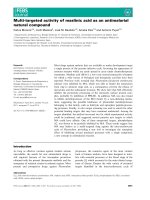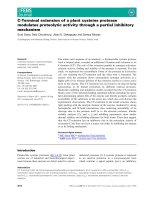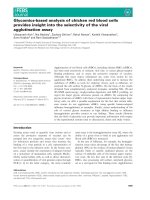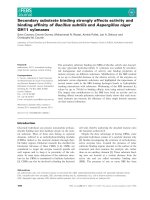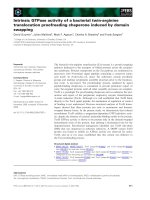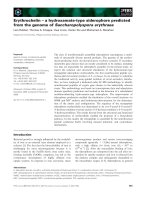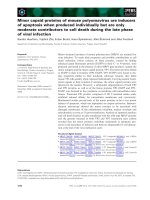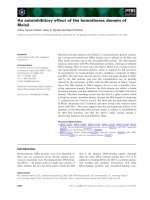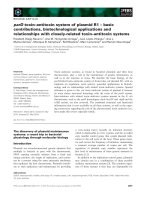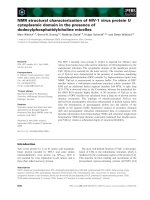Báo cáo khoa học: " SemiCytokines levels, Severity of acute mucositis and the need of PEG tube installation during chemo-radiation for head and neck cancer a prospective pilot study" ppt
Bạn đang xem bản rút gọn của tài liệu. Xem và tải ngay bản đầy đủ của tài liệu tại đây (388.68 KB, 7 trang )
RESEARC H Open Access
Cytokines levels, Severity of acute mucositis
and the need of PEG tube installation during
chemo-radiation for head and neck cancer -
a prospective pilot study
Amichay Meirovitz
1†
, Michal Kuten
2*†
, Salem Billan
3
, Roxolyana Abdah-Bortnyak
3
, Anat Sharon
4
, Tamar Peretz
1
,
Mordechai Sela
4
, Moshe Schaffer
3
, Vivian Barak
1
Abstract
Background: The purpose of this pilot study was to detect a correlation between serum cytokine levels and
severity of mucositis, necessitating installation of a percutaneous endoscopic gastrostomy tube (PEG) in head and
neck (H&N) cancer patients receiving combined chemo-radiation therapy.
Patients and Methods: Fifteen patients with H&N epithelial cancer were recruited to this study. All patients
received radiotherapy to the H&N region, with doses ranging from 50-70 Gy. Chemotherapy with cisplatin,
carboplatin, 5-fluorouracil and taxanes was given to high-risk patients, using standard chemotherapy protocols.
Patients were evaluated for mucositis according to WHO common toxicity criteria, and blood samples were drawn
for inflammatory (IL-1, IL-6, IL-8, TNF-a) and anti-inflammatory (IL-10) cytokine levels before and during treatment.
Results: A positive correlation was found between IL-6 serum levels and severity of mucositis and dysphagia;
specifically, high IL-6 levels at wee k 2 were correlated with a need for PEG tube installation. A seemingly
contradictory correlation was found between low IL-8 serum levels and a need for a PEG tube.
Conclusion: These preliminary results, indicating a correlation between IL-6 and IL-8 serum levels and severity of
mucositis and a need for a PEG tube installation, justify a large scale study.
Introduction
More than 60% of all squamous cell tumors of the head
and neck are treated by ionizing irradiation or radio-
chemotherapy and, more recently, by radiation com-
bined with biological treatment (targeted therapy) suc h
as Erbitux [1]. The most frequent side effect of treat-
ment is mucos itis that can appear in severe modes,
especially in patients treated with radio-chemotherapy.
This side effect can hinder the process of the treatment
and, in the long-term, be followed by xerostomia [2].
Severe form of mucositis can occur anytime between
week 2-6 of treatment, related to the chemotherapy
regimen and the technique and fractionation of radio-
therapy. The symptoms usually become more severe
with treatment and remain for weeks after the end of
therapy [1]. Severe mucositis is followed by other symp-
toms, such as pain, dysphagia, weight loss and other
symptoms that can influence therapy [2]. To avoid
cachexia and to provide necessary alimentation, installa-
tion of percutaneous endoscopic gastrostomy tubes
(PEG) is performed [3]. This can be an expensive under-
taking, as the cost in the USA is estimated at $3000 ±
1000 per patient.
The correlation between ending therapy because of
side effects and therapy success has been shown by
Alden et al [3]. The early detection of high-ri sk patients
who might have severe mucositis and dysphagia can be
very important from therapeutic and economic points of
view [4]. The severity of the mucositis depends on var-
ious factors, such as total dose and dose per fraction,
fractionation schedule (standard or altered), irradiation
* Correspondence:
† Contributed equally
2
School of Dental Medicine, Hadassah-Hebrew University, Jerusalem, Israel
Meirovitz et al. Radiation Oncology 2010, 5:16
/>© 2010 Meirovitz et al; licensee BioMed Central Ltd. This is an Open Access article distributed under the terms of the Creative
Commons Attr ibution License ( icens es/by/2.0), which permits unrestricted use, distribution, and
reproduction in any medium, provided the original work is properly cited.
fields, type of chemotherapy, and individual mouth
hygiene during and before treatment. Smoking and alco-
hol consumption during therapy will e nhance severity.
The variability of factors creates difficulty in determin-
ing which patients will develop severe mucositis. To
avoid the consequences of side effects, most centers pro-
vide the installation of gastrostomy tubes to all head and
neck (H&N) cancer patients. This installation is not
always necessary but, to date, there is no method to
determine in advance which patient will suffer from
severe mucositis and dysphagia and which will not [5].
Mucositis has four phases [2]: a) inflammation; b)
epithelial; c) ul cera; d) r epair. The inflammation phase,
also called the initial tissue injury phase, ends with the
production of cytokines such as IL-1 and TNF-a [2].
The pro-inflammation cytokines IL-1 and TNF-a are
present in high levels in blood and serum during inflam-
mation, and anti-inflammation cytokines are at low
levels. This cytokine balance is very important during
the inflammation process [6]. A correlation between IL-
1andTNF-a levels and the response of the tumor to
treatment was found in patients with breast cancer [7],
with a better clinical response following low levels of IL-
1 and TNF-a.
Markers, such as cytokeratin TPS, were found to be
indicators of the response of the tumor to treatment
and prognosis [7].
In squamous cell tumors of the H&N, Chen et al.
found inflammatory cytokines that are pro-angiogenet ic
and immuno-regulators [8]. These cytokines are pro-
duced from the tumor cells themselves and can be an
indication of the pathogenesis of the tumor [8]. In this
regard, a correlation was found between high levels of
inflammation cytokines IL-6 and IL-8 in the serum of
patients suffering from squamous cell cancer of the
H&N as a reaction to stimulation by pro-inflammatory
cytokines such as IL-1 and TNF-a [8,9].
IL-6 cytokines have an influence on the proliferation
and penetration capacity of squamous tumor cells in
vitro [10]. IL-6 is also a regulator of various chronic
inflammatory processes that can create better conditions
for tumor growth [10]. High levels of cytokine IL-8 in
the serum of patients with H&N tumors has shown cor-
relation with the aggressivene ss of the tumor and tumor
growth [11].
The aim of this pilot study was to find indicators, such
as high levels of cytokines, of the severity of mucositis in
patients suffering from H&N tumors, who need to
receive radiation therapy alone or combined with
chemotherapy.
Patients and Methods
Fifteen patients (12 males, 3 females), median age 51.8
years (range, 18-75 years), with a variety of H&N tumors
took part in this pilot study (Table 1). The patients
were treated in two hospitals: Hadassah Medical Cente r
in Jerusalem and Rambam Health Care Campus in
Haifa. All patients were treated with radiation therapy
(60-72 Gy), or radio-chemotherapy. RTOG/EORTC
recommendations for post-operative radio-chemother-
apy [12,13] were adopted in high-risk patients (Table 2).
Chemotherapy was applied as concomitant chemo-
radiotherapy, adjuvant chemotherapy or neo-adjuvant
chemo-radiotherapy. After approval from the local Insti-
tutional Review Board, all patients gave written consent
to participate in this study.
PEG tube installation was preformed based on clinical
evaluation prior, during or at the end of treatment.
All patients had clinical evaluations one week before
treatment, in the second and fourth weeks of treatme nt,
and at the end of treatment. WHO common toxicity cri-
teria were used (Grades 1 to 4). Weights were controlled
and samples of saliva were collected.
Blood samples were drawn four times (one week before
treatment, at the second a nd fourth weeks of treatment,
and at th e end of treatment) for the evaluation of in flam-
matory cytokines IL-1, IL-6, IL-8, TNF-a and the anti-
inflammatory cytokine IL-10. This evaluation was done
with DPC’ s ELISA kits in the quantitative “ sandwich”
enzyme immunoassay technique. A monoclonal antibody
specific for the interleukin molecule evaluated was intro-
duced into the wells. Standard antigens together with the
serum samples drawn from patients were also introduced
into the wells and the interleukin present was bound by
the immobilized antibody. After washing away any
Table 1 Patient characteristics
Parameter No. of patients %
Site of Disease
Nasopharynx 5 33.3
Oropharynx 1 6.7
Hypopharynx 1 6.7
Tongue 1 6.7
Supraglottic larynx 4 26.6
Tonsil 2 13.3
Cervical lymph nodes of unknown primary 1 6.7
Histology
Undifferentiated nasopharyngeal carcinoma 2 13.3
Squamous cell carcinoma 13 86.7
Stage
III 2 13.3
IVa 9 60
IVb 2 13.3
IVc 1 6.7
Loco-regionally advanced, NOS 1 6.7
Meirovitz et al. Radiation Oncology 2010, 5:16
/>Page 2 of 7
unbound proteins, the second enzyme-linked antibody
specific for the interleukin was added to the wells to
“sa ndwich” the interleukin immobilized during the first
incubation. Following a wash to remove any unbound
antibody-enzyme reagent, a substrate solution was added
to the wells and color developed in proportion to the
amount of the cytokine bound in the initial step. By com-
paring the optical density of the samples to a standard
curve, the concentration of the interleukin in unknown
samples is determined.
Statistical analysis was done using SPSS (Chicago IL,
USA) with Fisher’ s exact test. The small number of
patients forced the use of two-tailed tests to evaluate
the statistical hypothesis. Differences between cytokine
values at various times were checked with the Mann-
Wittney U test. The correlation between cytokine levels
and mucositis was checked with the Kruskal Wallis test.
Differences between mucositis evaluation for installation
of a PEG tube were checked using the Pearson Chi-
Square test and Fisher’s Exact Test. Statistical difference
was defined as p < 0.05.
Results
Seven (46.7%) of the 15 patients requir ed installation of
a PEG tube during radio-chemo therapy, and one female
patient needed installation of a PEG tube after ending
therapy. Three patients from the group that received
PEG tubes needed a break in therapy because of severe
side effects. After a short pause, therapy was renewed.
One patient died shortly after treatment because of mul-
tiple metastases.
The mucositis evaluation showed mucositis grade IV
in 30% of the patients after the 4
th
treatment week.
After six weeks of treatment, the number of patients
with grade IV mucositis was less (in accordance with
boost irradiation to a smaller irradiation field). Patients
who showed Grade IV mucositis at week 4 needed to
have PEG tube installation (Table 3).
Saliva control at rest and after stimulation by patients
who needed a PEG tube showed low secretion of saliva
during the second and fourth weeks of treatment, com-
pared to before irradiation. Secretions were higher at
the end of therapy. In comparison, patients who did not
need a PEG tube showed enhance d secretion from the
end of the second week (Table 4).
The level of cytokines measured before an d during
therapy showed increased IL-6, decreased TNF-a,and
increased IL-8, especially after the second week of ther-
apy. IL-1 and IL-10 did not show any significant changes.
Table 2 Treatment modalities
Parameter No. of patients %
Surgery
No 11 73.3
Yes 4 26.7
Radiotherapy
Total tumor dose, Gy
60 2 13.3
66 2 13.3
70 10 66.7
72 1 6.7
RT Technique
2D 3 20
3D 10 66.7
IMRT 2 13.3
Parotid sparing
No 13 86.7
Yes 2 13.3
RT interruptions
Yes (3 d, 6 d, NOS) 3 20
No 12 80
Chemotherapy
Neoadjuvant chemotherapy
No 7 46.6
Yes:
Cisplatin/5FU
1
640
Carboplatin/5FU
2
1 6.7
Docetaxel/5FU/Cisplatin
3
1 6.7
Concomitant Chemotherapy
Carboplatin
4
1 6.7
Cisplatin
5
14 93.3
1
Cisplatin 100 mg/m
2
, I.V., day 1; 5-Fluorouracil 1000 mg/m
2
I.V., continuous
infusion, days 1-5, every 21 days
2
Carboplatin AUC 2, I.V., day 1; 5-Fluorouracil 1000 mg/m
2
I.V. continuous
infusion, days 1-5, every 21 days
3
Docetaxel 75 mg, Cisplatin 75 mg I.V. day 1; 5-Fluorouracil 750 mg I.V.,
continuous infusion, days 1-5, every 21 days
4
Carboplatin ACU 2, I.V., weekl y
5
Cisplatin 40 mg/m
2
I.V., weekly
Table 3 Mucositis grade correlated to installation of PEG
tube
Need for PEG tube No need for PEG tube
Time* W0 W2 W4 End W0 W2 W4 End
Mucositis grade
1 50% 0% 0% 66.7% 42.9% 0%
2 25% 0% 66.7% 33.3% 28.6% 66.7%
3 25% 33.3% 0% 0% 28.6% 33.3%
4 0% 66.7% 33.3% 0% 0% 0%
Notes*
W0 = 1 week before treatment
W1 = first treatment week
W2 = second treatment week
W3 = third treatment week
W4 = fourth treatment week
End = end of treatment
Meirovitz et al. Radiation Oncology 2010, 5:16
/>Page 3 of 7
A relationship b etween high levels of IL-6 and the need
for a PEG tube was observed. The seven patients who
needed a PEG tube had a median IL-6 of 5.6 pg/ml, while
patients who did not need a PEG tube had a median of
3.2 pg/ml (p = 0.063). During the second week, a correla-
tion betwe en low levels of IL-8 and PEG tube was found:
6.7 pg/ml with PEG tube versus 13.65 pg/ml without
PEGtube(p=0.031).Theothercytokines,IL-10,IL-1,
and TNF-a, did not show any correlation with PEG tube
instal lation. The correlation between cytokine le vels and
PEG tube installation is shown in Figure 1.
An even stronger correlation was found between the
difference in IL-6 serum levels from baseline values
(week 0) to the second week of treatment and the need
for PEG tube installation. The patients who needed a
PEG tube during treatment had a median difference in
IL-6 levels between week 2 and week 0 of 3.0, while
patients who did not need a PEG tube had a negative
median value of -0.75 (p = 0.022). The correlation
between differences in IL-6 levels measured in week 2
as opposed to those measured in week 0 and PEG tube
installation is shown in Figure 2.
A relationship betw een high le vels of IL-6 and a high
grade of mucositis at week 4 was found (p = 0.081), but
no such relationship between IL-1, TNF-a,IL-8orIL-
10 level and mucositis grade was shown.
Discussion
Radio-chemotherapy leads to various side effects in the
irradiated area. These side effects are acute an d chronic,
and have an influence on the quality of life of the
patients [14]. Mucositis is one of the main acute side
effects that can lead to therapy del ay, compromising
optimal treatment. T he mucositis usually appears in the
second and third weeks of therapy, and the installation
of a PEG tube is needed in some cases [4]. Chronic side
effects can appear weeks and even years after therapy
[15], especially dry mouth, caries, tissue necrosis, fibrosis
and radio-osteonecrosis.
We have shown a correlation between inflammatory
and anti-inflammatory cytokines and acute mucositis
with a need for PEG tube installation. Seven of 15
patients who took part in this pilot study needed PEG
tube installation due to the severity of radio-che-
motherapy side effects. Weight loss and decreased
secretion of saliva was observed in all patients. These
two phenomena were enhanced in the seven patients
who needed PEG tube installation. The slight enhance-
ment of saliva secretion at the fo urth week of treat-
ment can be explained by the small irradiation field
("boost” irradiation). The first phase of mucositis dur-
ing radio-chemotherapy was characterized by the pro-
duction of inflammatory cytokines, such as IL-1, TNF-
a and IL-6, that coordinate this process in the oral
mucosa [2]. It has bee n demonstrated that the increase
of IL-8 and IL-6 and the increase of proteins such as
C-reactive protein play an important role in the patho-
genesis of H&N squamous cell tumors [8]. Long-term
changes in levels of IL-8 and IL-6 after thera py are
Table 4 Saliva secretion at rest and after stimulation in
patients with and without PEG tube
Need for PEG
tube
No need for PEG
tube
Time* W0 W2 W4 End W0 W2 W4 End
Saliva, cc/minute (median)
At rest 2 0.8 0.3 1 2.1 1 1 1
After stimulation 1.7 1 0.3 1 2.5 1 1.3 1.5
Notes*
W0 = 1 week before treatment
W1 = first treatment week
W2 = second treatment week
W3 = third treatment week
W4 = fourth treatment week
End = end of treatment
Figure 1 Cytokine levels during treatment correlated to PEG tube installation.
Meirovitz et al. Radiation Oncology 2010, 5:16
/>Page 4 of 7
connected with tumor response to treatment and with
tumor progress [16].
This study was aimed at finding a correlation between
cytokine levels and the need for PEG tube installation
due to mucositis during radiation therapy of H&N squa-
mous cell cancers. We observed high levels of cytokine
IL-6 (Figure 1), with a need for PEG tube installation.
An even stronger correlation (p = 0.022) between the
difference in IL-6 serum levels from baseline values
(week 0) to second week of treatment and the need for
PEG tube installation was seen (Figure 2). Low levels of
IL-8 showed a need for a PEG tube and high levels
showed no need (p = 0.031).
We were unable to detect any co rrelatio n between IL-
1, TNF-a, and IL-10 levels and mucositis. IL-10 is
known as an anti-inflammatory cytokine [17], but we
did not find any significant changes in IL-10 levels dur-
ing radio-chemotherapy.
In some reports, elevated levels of TNF-a were docu -
mented during irradiation of H&N tumors. This fact
leads to suggested treatment with TNF-a cytokines to
avoid inflammation [18,19]. In our study, we observed
the opposite e ffect, a decrease of the TNF-a level (Fig-
ure 1). TNF-a has an important interaction with other
cytokines and hormones. This cytokine influences cell
proliferation, various intra-cellular processes and cyto-
static effects that, in the presence of IFN-g, create a
cytotoxic effect [6].
We did not observe any change of IL-1 levels in our
patients, in contrast to other studies [20] that showed
enhancement of IL-1 in patients with mucositis. Fibro-
blasts, B lymphocytes, and endothelial cells can produce
IL-1, a cytokine-induced cytokine which participates in
various biological processes, including acute inflamma-
tion [20].
During radio-chemotherapy, IL-8 was detected in rela-
tively low levels in patients who needed PEG tube instal-
lation. This low level i s quite paradoxical, as we
presume that high levels of i nflammatory cytokines are
correlated with severe mucositis. Our study dealt with
the reaction of healthy tissues to ionizing irradiation
and not in tumors. A similar finding was observed in a
study published by Hart et al from Duke University [21]
on the influence of irradiation on healthy lung tissue
during treatment of bronchial cancer, comparing IL-8
levels prior to irradiation and the probability of develop-
ing radiation pneumonitis. All patients showed high
levels of IL-8, but a correlation between relatively low
levels of IL-8 and an inflammatory process were
observed. It was then suggested that IL-8 plays a role
against irradiation damage [21].
Our study showed a correlation between high levels
of IL-6 and severe mucositis. The presence of this
cytokine in blood is known but a level higher than 10
pg/ml is abnormal and can lead to chronic inflamma-
tion [22]. IL-6 has an important role in the acute
phase response [6] and can be found in several ill-
nesses, such as multiple myeloma and bowel inflamma-
tion. IL-6 and its receptor, IL-6R, were found in
various tumors, such as in the kidney, lung, ovary,
H&N and cervix [9,23]. An in vitro study on human
squamous cell cancer showed that high concentrations
of IL-6 will influence the invasion of tumor cells and
that metastasis is possible [24]. The same was
Figure 2 Change in IL-6 serum levels between second week of treatment and week 0 for each individual patient, correlated to PEG
tube installation.
Meirovitz et al. Radiation Oncology 2010, 5:16
/>Page 5 of 7
demonstrated in an in vivo control [9]. Other studies
reviewed the correlation between IL-6 before radio-
chemotherapy and cancer therapy resistance, including
the possibility of metastases. A correlation between IL-
6 levels and re currence was shown, leading to the con-
clusion that IL-6 can be an indicator of tumor aggres-
siveness [25].
In a more recent publication, Haddad et al. assessed
the use of Amifostine during head and neck chemo-
radiation for prevention of mucositis. In their small ran-
domized study, the authors investigated cytokine levels
during chemo-radiotherapy. They found an elevation in
serum l evels of cytokines IL-6, TNF-a and IL-1b which
correlated with mucositis severity, and also showed that
Amifostine did not reduce mucositis severity. This study
confirmed the positive relationship between cytokine
levels and mucositis [26].
This pilot study, due to its small sample size, cannot
provide a definitive answer to the question o f the rela-
tionship between levels of IL-6 and IL-8 and severity
of mucositis during and after radiotherapy. In addition,
it should be emphasized that because of the small sam-
ple size, this study may have limitations due to lack of
uniformity of radiation dose and technique and the
heterogeneity in the chemotherapy regimens employed,
especially in the neoadjuvant setting. Therefore, this
pilot study can only give an indication, and further
studies with larger sample scales are needed, especially
to consider the genotype (e.g., SNPs - Single Nucleo-
tide Polymorphism [27]) that can lead to severe muco-
sitis during and after radio-chemotherapy in H&N
tumors. A correlation betwee n high IL-6 levels and
relatively low IL-8 levels during inflammation, and the
severity of radiation-induced mucositis may serve as a
prognostic factor to predict the need for PEG tube
installation during the first part of treatment, thus pla-
cing it prior to the development of complications.
Identifying SNPs associated with clinical radio-sensitiv-
ity in future studies, in addition t o serum cytokine
levels, could lead to predicting adverse response to
radiotherapy.
Author details
1
Department of Oncology, Hadassah-Hebrew University Medical Center,
Jerusalem, Israel.
2
School of Dental Medicine, Hadassah-Hebrew University,
Jerusalem, Israel.
3
Division of Oncology, Rambam Health Care Campus and
Faculty of Medicine, Technion-Israel Institute of Technology, Haifa, Israel.
4
Department of Maxillofacial Prosthetics, Hadassah-Hebrew University
Medical Center, Jerusalem, Israel.
Authors’ contributions
AM participated in the design of the study and clinical evaluations. MK
participated in the design of the study and clinical evaluations, and carried
out the writing of the manuscript. SB, RAB, AS, TP and MS carried out the
clinical evaluations. MSc drafted the manuscript. VB participated in the
design of the study and carried out the laboratory analysis. All authors read
and approved the final manuscript.
Competing interests
The authors declare that they have no competing interests.
Received: 27 October 2009
Accepted: 25 February 2010 Published: 25 February 2010
References
1. Wong PC, Dodd MJ, Miaskowski C, Paul SM, Bank KA, Shiba GH, Facione N:
Mucositis pain induced by radiation therapy: prevalence, severity, and
use of self-care behaviors. J Pain Symptom Manage 2006, 32:27-37.
2. Scully C, Epstein J, Sonis S: Oral mucositis: a challenging complication of
radiotherapy, chemotherapy, and radiochemotherapy: part 1,
pathogenesis and prophylaxis of mucositis. Head Neck 2003,
25:1057-1070.
3. Alden ME, O’Reilly RC, Topham A, Lowry LD, Brodovsky H, Curran WJ Jr:
Elapsed radiation therapy treatment time as a predictor of survival in
patients with advanced head and neck cancer who receive
chemotherapy and radiation therapy. Radiology 1996, 201:675-680.
4. Wood K: Audit of nutritional guidelines for head and neck cancer
patients undergoing radiotherapy. J Hum Nutr Diet 2005, 18:343-351.
5. Peterman A, Cella D, Glandon G, Dobrez D, Yount S: Mucositis in head and
neck cancer: economic and quality-of-life outcomes. J Natl Cancer Inst
Monogr 2001, 45-51.
6. Whicher JT, Evans SW: Cytokines in disease. Clin Chem 1990, 36:1269-1281.
7. Barak V, Kalickman I, Nisman B, Farbstein H, Fridlender ZG, Baider L,
Kaplan A, Stephanos S, Peretz T: Changes in cytokine production of breast
cancer patients treated with interferons. Cytokine 1998, 10:977-983.
8. Chen Z, Malhotra PS, Thomas GR, Ondrey FG, Duffey DC, Smith CW,
Enamorado I, Yeh NT, Kroog GS, Rudy S, McCullagh L, Mousa S, Quezado M,
Herscher LL, Van Waes C: Expression of proinflammatory and
proangiogenic cytokines in patients with head and neck cancer. Clin
Cancer Res 1999, 5:1369-1379.
9. Kanazawa T, Nishino H, Hasegawa M, Ohta Y, Iino Y, Ichimura K, Noda Y:
Interleukin-6 directly influences proliferation and invasion potential of
head and neck cancer cells. Eur Arch Otorhinolaryngol 2007, 264:815-821.
10. Heikkila K, Ebrahim S, Lawlor DA: Systematic review o f the association
between circulating interleukin-6 (IL-6) and cancer. Eur J Cancer 2008,
44:937-945.
11. Gokhale AS, Haddad RI, Cavacini LA, Wirth L, Weeks L, Hallar M, Faucher J,
Posner MR: Serum concentrations of interleukin-8, vascular endothelial
growth factor, and epidermal growth factor receptor in patients with
squamous cell cancer of the head and neck. Oral Oncol 2005, 41:70-76.
12. Bernier J, Domenge C, Ozsahin M, Matuszewska K, Lefèbvre JL, Greiner RH,
Giralt J, Maingon P, Rolland F, Bolla M, Cognetti F, Bourhis J, Kirkpatrick A,
van Glabbeke M, European Organization for Research and Treatment of
Cancer Trial 22931: Postoperative irradiation with or without concomitant
chemotherapy for locally advanced head and neck cancer. N Engl J Med
2004, 350:1945-1952.
13. Cooper JS, Bernier J: Rationale for triage in the postoperative
management of head and neck cancers. Oncology 2005, 19:1011-1017.
14. Vissink A, Jansma J, Spijkervet FK, Burlage FR, Coppes RP: Oral sequelae of
head and neck radiotherapy. Crit Rev Oral Biol Med
2003, 14:199-212.
15. Sciubba JJ, Goldenberg D: Oral complications of radiotherapy. Lancet
Oncol 2006, 7:175-183.
16. Druzgal CH, Chen Z, Yeh NT, Thomas GR, Ondrey FG, Duffey DC, Vilela RJ,
Ende K, McCullagh L, Rudy SF, Muir C, Herscher LL, Morris JC, Albert PS, Van
Waes C: A pilot study of longitudinal serum cytokine and angiogenesis
factor levels as markers of therapeutic response and survival in patients
with head and neck squamous cell carcinoma. Head Neck 2005,
27:771-784.
17. Pestka S, Krause CD, Sarkar D, Walter MR, Shi Y, Fisher PB: Interleukin-10
and related cytokines and receptors. Annu Rev Immunol 2004, 22:929-979.
18. Akmansu M, Unsal D, Bora H, Elbeg S: Influence of locoregional radiation
treatment on tumor necrosis factor-alpha and interleukin-6 in the serum
of patients with head and neck cancer. Cytokine 2005, 31:41-45.
19. Xanthinaki A, Nicolatou-Galitis O, Athanassiadou P, Gonidi M, Kouloulias V,
Sotiropoulou-Lontou A, Pissakas G, Kyprianou K, Kouvaris J, Patsouris E:
Apoptotic and inflammation markers in oral mucositis in head and neck
cancer patients receiving radiotherapy: preliminary report. Support Care
Cancer 2008, 16:1025-1033.
20. Dinarello CA: Biology of interleukin 1. FASEB J 1988, 2:108-115.
Meirovitz et al. Radiation Oncology 2010, 5:16
/>Page 6 of 7
21. Hart JP, Broadwater G, Rabbani Z, Moeller BJ, Clough R, Huang D,
Sempowski GA, Dewhirst M, Pizzo SV, Vujaskovic Z, Anscher MS: Cytokine
profiling for prediction of symptomatic radiation-induced lung injury. Int
J Radiat Oncol Biol Phys 2005, 63:1448-1454.
22. Hodge DR, Hurt EM, Farrar WL: The role of IL-6 and STAT3 in
inflammation and cancer. Eur J Cancer 2005, 41:2502-2012.
23. Woods KV, El-Naggar A, Clayman GL, Grimm EA: Variable expression of
cytokines in human head and neck squamous cell carcinoma cell lines
and consistent expression in surgical specimens. Cancer Res 1998,
58:3132-3141.
24. Nishino H, Miyata M, Kitamura K: The effect of interleukin-6 on enhancing
the invasiveness of head and neck cancer cells in vitro. Eur Arch
Otorhinolaryngol 1998, 255:468-472.
25. Duffy SA, Taylor JM, Terrell JE, Islam M, Li Y, Fowler KE, Wolf GT, Teknos TN:
Interleukin-6 predicts recurrence and survival among head and neck
cancer patients. Cancer 2008, 113:750-757.
26. Haddad R, Sonis S, Posner M, Wirth L, Costello R, Braschayko P, Allen A,
Mahadevan A, Flynn J, Burke E, Li Y, Tishler RB: Randomized Phase 2 Study
of Concomitant Chemoradiotherapy Using Weekly Carboplatin/Paclitaxel
With or Without Daily Subcutaneous Amifostine in Patients With Locally
Advanced Head and Neck Cancer. Cancer 2009, 115:4514-23.
27. Vairaktaris E, Yapijakis C, Serefoglou Z, Avgoustidis D, Critselis E,
Spyridonidou S, Vylliotis A, Derka S, Vassiliou S, Nkenke E, Patsouris E: Gene
expression polymorphisms of interleukins-1b, -4, -6, -8, -10, and tumor
necrosis factors-a, -b: regression analysis of their effect upon oral
squamous cell carcinoma. J Cancer Res Clin Oncol 2008, 134:821-832.
doi:10.1186/1748-717X-5-16
Cite this article as: Meirovitz et al.: Cytokines levels, Severity of acute
mucositis and the need of PEG tube installation during chemo-radiation
for head and neck cancer - a prospective pilot study. Radiation Oncology
2010 5:16.
Submit your next manuscript to BioMed Central
and take full advantage of:
• Convenient online submission
• Thorough peer review
• No space constraints or color figure charges
• Immediate publication on acceptance
• Inclusion in PubMed, CAS, Scopus and Google Scholar
• Research which is freely available for redistribution
Submit your manuscript at
www.biomedcentral.com/submit
Meirovitz et al. Radiation Oncology 2010, 5:16
/>Page 7 of 7
